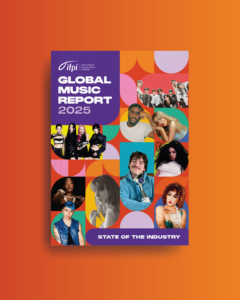Global recorded music revenues have grown for the tenth consecutive year, up 4.8% to US$29.6 billion in 2024, according to the IFPI’s Global Music Report 2025 . The newly released report provides the most comprehensive review of the global music market and analyzes issues and trends within the industry.
Global revenue growth was largely driven by paid subscription streaming, with an increase of 9.5%, while ad-supported streaming grew by 1.2%. Globally, the number of subscription account users grew 10.6% year-over-year to 752 million users. 
All told, streaming revenues exceeded US$20 billion (US $20.4 billion) for the first time ever, and represented 69% of total recorded music revenues. To put that figure in perspective, US$20 billion is more than the revenues of the entire recorded music industry for each year between 2003 and 2020.
Every region of the world experienced revenue growth in 2024, with three of the world’s seven regions posting double-digit gains: Middle East & North Africa (+22.8%), Sub-Saharan Africa (+22.6%) and Latin America (+22.5%).
The Canadian market – which remains the eighth largest in the world – saw revenue grow to US$660.3 million. While the market increased by just 1.53% year over year, Canada’s 2024 revenues are in comparison to a 2023 figure which included a large one-off payment in performance rights revenues.
Like other global markets, growth in Canada was largely driven by streaming, which increased 4.2% to US$520.1 million. Of that, subscription streaming accounts for the majority of those revenues with US$422.7 million, up 6.2% year-over-year.
“This report clearly demonstrates that Canada must continue to foster a healthy music environment for artists, record labels and their partners. Canada’s major labels invest heavily in finding new talent, breaking Canadian and Indigenous artists at home and around the world, and developing new technologies to help them achieve their commercial and creative goals. A robust Canadian market is what enables that re-investment and the success of future generations of talent,” says Patrick Rogers, CEO of Music Canada.
Commenting on the release of the Global Music Report, Victoria Oakley, CEO, IFPI, said: “One of the key issues we’ve looked at in this report is the role of AI in music. Record companies have embraced its potential to enhance artist creativity and develop new and exciting fan experiences. However, it is very clear that the developers of generative AI systems ‘ingesting’ copyright-protected music to train their models without authorisation from the rightsholders poses a very real and present threat to human artistry.
We are asking policymakers to protect music and artistry. We must harness the potential of AI to support and amplify human creativity, not to replace it.”
The free Global Music Report 2025 – State of the Industry report is now available here.
ENDS
Note to Editors:
About Music Canada:
Music Canada is the trade association representing Canada’s major record labels: Sony Music Entertainment Canada, Universal Music Canada and Warner Music Canada. Like its members, Music Canada is a partner to the industry, working with artists, independent labels, publishers, platforms, associations and others, in advancing forward-looking policies to ensure a dynamic and successful Canadian music ecosystem which returns value to music creators.
For further information: Regan Reid, Music Canada, rreid@musiccanada.com, (416) 462-1485
About IFPI
IFPI is the voice of the recording industry worldwide, representing more than 8,000 record company members across the globe. We work to promote the value of recorded music, campaign for the rights of record producers and expand the commercial uses of recorded music around the world.
For further information please contact:press@ifpi.org| +44 (0)20 7878 7979

 Amazon has announced the arrival of
Amazon has announced the arrival of 
Music Canada